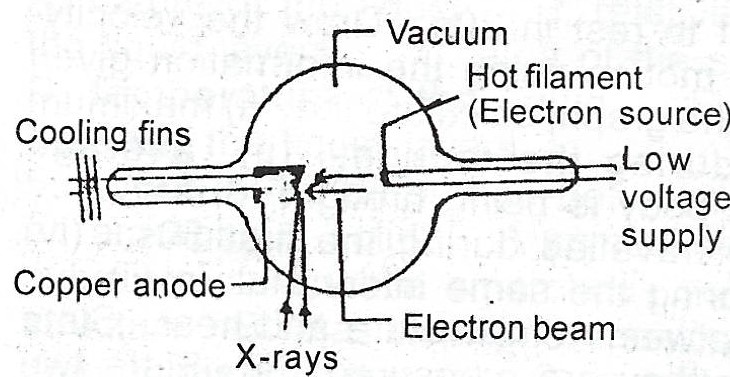(a)(i) By means of a labelled diagram, describe the mode uf operation of a modern X-ray tube.
(ii) State the energy transformation which takes place during the operation.
(b) Explain the terms hardness and intensity as applied to X-rays
(c)(i) State three uses of X-rays
(ii) State one hazard of over-exposure to X-rays in a radiological laboratory, indicating two safety precautions.
(a)(i) 
Mode of Operation:
In the X-ray tube a Low voltage high p.d is applied between the hot cathode and the anode. Electrons are emitted from the cathode and are accelerated to an extremely high speed. They are suddenly decelerated when they strike the anode causing the emission of high - energy radiation of short wavelength - X-ray. In this process the anode becomes very hot, and requires cooling fins on the outside of the tube.
Energy Transformation: The electrons have kinetic energy which is partly changed to internal energy (potential) and finally changed to heat energy.
(b) Hardness: Refers to X-rays with high penetrating power, short wavelength but high frequency. They are produced by increasing the p.d. between the cathode and anode. Such X-rays are called hard X-rays. Less penetrating or lower frequency ones are called soft X-rays. They are produced at lower p.d.
Intensity: High intensity X-rays beam results from the increase of current through the filament which leads to increase in the number of electrons.
(c)(i) Uses of X-rays:
(1) Investigating the structure of crystals ; (2) X-ray examination of the body for broken bones; (3) As invincible bullets for the treatment of tumours ; (4) Examination of metals for defects and fractures.
(ii) They may cause damage to living tissue and to cells. Precaution to be taken includes lead screening and regular health checks.
Contributions ({{ comment_count }})
Please wait...
Modal title
Report
Block User
{{ feedback_modal_data.title }}